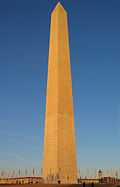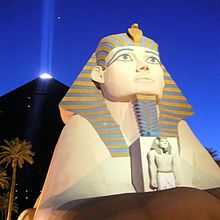Egyptomania

Egyptomania was the renewed interest of Europeans in ancient Egypt during the nineteenth century as a result of Napoleon's Egyptian Campaign (1798–1801) and, in particular, as a result of the extensive scientific study of ancient Egyptian remains and culture inspired by this campaign. In addition to its aesthetic impact on literature, art and architecture, it also played a role in the discussion about race, gender and national identity. Egyptomania is of particular importance to American culture because of the way in which the example of ancient Egypt served to create a sense of independent nationhood during the nineteenth century.[2] However, Egypt has had a significant impact on the cultural imagination of all Western Cultures.[3]
Culture


Egyptian images and symbols also served for more trivial purposes, such as dessert services, furniture, decoration, commercial kitsch or even advertising.[4] There were parties and public events that had Egypt as a motto, where people wore special costumes. In general, people were fascinated by everything that had the label Egypt attached to it. And even today, this kind of fascination for Egypt and all things Egyptian still exists. Many different exhibitions about Egyptian culture in museums all over the world demonstrate people's continued interest in it.[5]

Fascinated by Egyptian culture, American literature, visual art and architecture absorbed what was becoming general knowledge about ancient Egyptian culture, making use of this knowledge in the contemporary debate about national identity, race, and slavery. Certain characteristic elements of Egyptian culture became particularly symbolically charged. The mummy, for example, represented the fascination of the Americans with the living dead, reanimation, revenge and anxiety about race.[6] This fascination went so far that 'mummy unwrapping parties' were organised, thus pushing the hysteria of the Americans with Egyptian myths further and further.[7] The figure of Cleopatra, hieroglyphic writing and deciphering, and the pyramid as maze and tomb are other examples of how ancient Egypt has been productive in the West, and specifically in the United States since the nineteenth century. Well-known literary works that make use of these symbolic references to Egypt include "Some Words With a Mummy" by E. A. Poe,[8] "Lost In A Pyramid Or The Mummy’s curse" by Louisa May Alcott[9] or The Marble Faun by Nathaniel Hawthorne. The impact of ancient Egyptian culture in architecture is called the Egyptian Revival, an important expression of neoclassicism in the United States. Well-known Egyptian images, forms and symbols were integrated in the contemporary style. This influence can best be seen in the architecture of cemeteries and prisons. Other examples of this influence are the Gold Pyramid House in Illinois or the famous Obelisk (Washington Monument) in Washington, D.C. Movies such as The Mummy (1999) (itself a remake of a 1932 Boris Karloff film) and its sequels demonstrate that ancient Egypt and the discovery of its secrets is still a powerful point of reference for contemporary western cultures. Important scholarly texts about this phenomenon in American culture include Scott Trafton’s Egypt Land (2004) and M. J. Schueller’s U.S. Orientalism (1998).
Science

In the early nineteenth century natural science based on Empiricism was still in its infancy. Though a lot of ground breaking discoveries were made, many ideas that were debated seriously by the intellectual community at that time may appear humorous at best, spurious and opportunistic at worst to observers from our time.[citation needed] This is true also with regard to Egyptology: the great interest in Egypt and its history spawned enormous efforts that produced indispensable knowledge as for instance the deciphering of hieroglyphics by Jean-François Champollion in 1824. Yet much of the work in and on Egypt was not performed by full-time scholars but by rich enthusiasts whose training and expertise did not quite match their interest.[citation needed] Major amounts of knowledge have been destroyed by poorly documented excavations and poorly performed dissections. The popularity of Egyptology in educated circles led to strange phenomena, as for instance when amateur Egyptologists would organize "Mummy Parties", social gatherings with a pseudo scientific outlook, which consisted mainly of "unwrapping" a mummy purchased for the purpose by the host.[citation needed]
Another rather strange chapter of nineteenth century science that is relevant with regard to Egyptomania is Craniology, the study of the human cranium that claimed to be able to determine an individual's intelligence and even character. Egyptian mummies served as an abundant source for the object of study — skulls. Craniology was especially important with regard of the question, whether Egyptians were black or white, a debate lead in light of the justification of slavery (see below). The key figure for this period seems to be Samuel George Morton who founded the American School of Ethnology. He put forward the theory of Polygenesis claiming that there is not one but several human races who are in a hierarchical order with whites at the top and blacks at the bottom end of the scale. Although science today disapproves of Morton's findings it still revalidated his professional status, because Morton's American School was to a large degree responsible for the development of the current professional status of the sciences and the renunciation of puritan ideas of monogenesis and the Christian, clerical worldview, common at the time.[10]
Race and national identity

Going back to ancient Greek and Roman descriptions[citation needed] of Egyptians, Afrocentrist thinkers in the nineteenth century insisted that the Egyptians were black Africans, making it possible to provide an ancient and noble lineage that countered the degrading images proliferated by racist science and pro-slavery polemic. Prominent contributors to this debate include David Walker, James McCune Smith, Frederick Douglass and W. E. B. Du Bois. Identifying with the enslaved Hebrews, African Americans had long used the biblical Exodus narrative to encode their right and desire for freedom, as the well-known spiritual "Go down, Moses" still testifies. David Walker's Appeal (1829) places this biblical story of liberation in tension with the assertion that the Pharaohs were black as well. The prominent black abolitionists James McCune Smith and Frederick Douglass countered white ethnography directly, as for example in Douglass' "Claims of the Negro Ethnologically Considered" (1854), drawing from findings of earlier European ethnologists such as James Prichard. At the turn of the 20th century, W. E. B. Du Bois shaped the concept of race and identity in yet another way by writing about the "double consciousness" of Africans in the "Diaspora", meaning the descendants of the slaves in the United States. This concept led to the twentieth century Black nationalist movements.
Notes
- ↑ cf. Trafton 2004, 2.
- ↑ cf. esp. Trafton 2004.
- ↑ For a chronological overview of the impact of Egypt on the Western imagination since ancient Greece see Egypt in the Western imagination.
- ↑ 4.0 4.1 cf. Whitehouse
- ↑ A prominent example, which also reflected upon the cultural meaning of this fascination, is the exhibition "Egyptomania: Egypt in Western Art, 1730-1930" (Paris, Musée Du Louvre, 20 January – 18 April 1994; Ottawa, National Gallery of Canada, 17 June – 18 September 1994; Vienna, Kunsthistorisches Museum, 16 October 1994 – 29 January 1995). The exhibition catalog was published by The National Gallery of Canada in 1994 (Humbert et al.).
- ↑ Trafton 2004:121-164
- ↑ cf. Trafton 2004:124-126
- ↑ cf. Trafton 2004:132-140
- ↑ cf. Trafton 2004:126-129
- ↑ 10.0 10.1 cf. Nelson 1998
- ↑ 11.0 11.1 Ater, 2003.
- ↑ cf. Nelson 1998.
- ↑ For example, Vincent Sarich and Frank Miele's Race: The Reality of Human Differences (2004), a recent attempt to add academic credibility to the popular — but scientifically discredited — notion that "race" constitutes an essential rather than a culturally constructed human difference, uses Egypt in a similar way.
References and further reading
- Ater, Renee. "Making History: Meta Warrick Fuller's 'Ethiopia". American Art 17.3 (2003): 12-31.
- Brier, Bob. Egyptomania. Brookville, NY: Hillwood Art Museum, 1992. ISBN 0-933699-26-3 (exhibition catalog)
- Curl, James Stevens. Egyptomania: The Egyptian Revival, A Recurring Theme in the History of Taste. Manchester University Press, 1994. Manchester, UK; New York: Manchester University Press, 1994. ISBN 0-7190-4126-0
- Draper, Theodore. The Rediscovery of Black Nationalism. New York: Viking Press, 1970. ISBN 0-670-59114-9
- Gillman, Susan. "Pauline Hopkins and the Occult: African-American Revisions of Nineteenth-Century Sciences" In: American Literary History, Vol 8, No.1, spring 1996, pp. 57–82
- Glaude, Eddie S. Exodus! Religion, Race, and Nation in Early Nineteenth-Century Black America. Chicago: University of Chicago Press, 2000. ISBN 0-226-29819-1
- Gruesser, John Cullen. Black on Black: Twentieth-Century African American Writing About Africa. Lexington, KY: University Press of Kentucky, 2000. ISBN 0-8131-2163-9
- Humbert, Jean-Marcel, et al. Egyptomania: Egypt in Western Art, 1730-1930. Ottawa: National Gallery of Canada, 1994. ISBN 0-88884-636-3 (Exhibition catalog: Paris, Musée Du Louvre, 20 January-18 April 1994; Ottawa, National Gallery of Canada, 17 June-18 September 1994; Vienna, Kunsthistorisches Museum, 16 October 1994-29 January 1995)
- Howe, Stephen. Afrocentrism: Mythical Pasts and Imagined Homes. London ; New York: Verso, 1998. ISBN 1-85984-873-7
- Nelson, Dana D. National Manhood: Capitalist Citizenship and the Imagined Fraternity of White Men. Duke University Press, 1998. ISBN 0-8223-2149-1
- Perniola, Mario, Enigmas. The Egyptian Moment in Society and Art, translated by Christopher Woodall, preface to the English Edition by the author, London-New York, Verso, 1995.
- Schueller, Malini Johar. U.S. Orientalisms: Race, Nation, and Gender in Literature, 1790-1890. Ann Arbor: University of Michigan Press, 1998. ISBN 0-472-10885-9
- Trafton, Scott Driskell. Egypt Land: Race and Nineteenth-Century American Egyptomania. New Americanists. Durham, N.C.: Duke University Press, 2004. ISBN 0-8223-3362-7
- Wallace, Maurice O. Constructing the Black Masculine: Identity and Ideality in African American Men's Literature and Culture, 1775-1995. Durham: Duke University Press, 2002. ISBN 0-8223-2854-2
- Whitehouse, Helen. Review Article: "Egyptomanias"' In: American Journal of Archaeology, Vol 101, No.1, Jan 1997, pp. 158–161.
External links
- egyptomania.org, a website devoted to covering all aspects of "Egyptomania" from both a scholarly and a popular perspective. Includes Bibliographies.
- , a website devoted to covering all aspects of "Egyptomania"
- American Egyptomania, a scholarly website maintained at George Mason University, under the guidance of Scott Trafton, the author of Egypt Land (2004). Focuses on expressions of Egyptomania in the United States starting in the early nineteenth century and includes excerpts from original documents.
- Underwood & Underwood Egypt Stereoviews, a digital library collection maintained by the American University in Cairo Rare Books and Special Collections Library. The collection highlights Egyptomania in the late nineteenth century.
| |||||||||||||||

